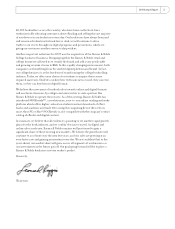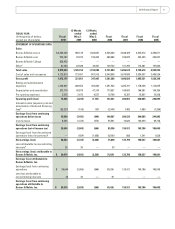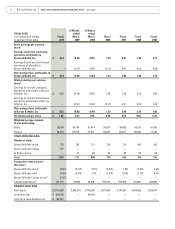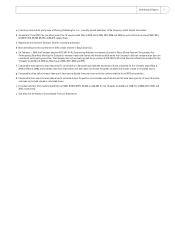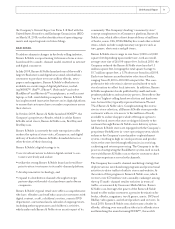Barnes and Noble 2010 Annual Report Download - page 15
Download and view the complete annual report
Please find page 15 of the 2010 Barnes and Noble annual report below. You can navigate through the pages in the report by either clicking on the pages listed below, or by using the keyword search tool below to find specific information within the annual report.
The following table sets forth, for the periods indicated, the percentage relationship that certain items bear to total sales of
the Company:
13 Weeks Ended
Fiscal Year Fiscal 2010 May 2, 2009 May 3, 2008 Fiscal 2008 Fiscal 2007
Sales 100.0% 100.0% 100.0% 100.0% 100.0%
Cost of sales and occupancy 71.1 70.0 69.9 69.1 69.6
Gross margin 28.9 30.0 30.1 30.9 30.4
Selling and administrative expenses 24.0 25.9 26.3 24.4 23.2
Depreciation and amortization 3.6 4.2 3.6 3.4 3.2
Pre-opening expenses 0.1 0.2 0.4 0.2 0.2
Operating margin (loss) 1.3 (0.3) (0.2) 2.8 3.8
Interest income, net and amortization of deferred
financing fees 0.5 — 0.1 — 0.1
Earnings (loss) from continuing operations before taxes 0.8 (0.3) (0.1) 2.8 4.0
Income taxes 0.1 (0.1) — 1.1 1.4
Earnings (loss) from continuing operations
(net of income tax) 0.6% (0.2)% —% 1.7% 2.6%
BUSINESS OVERVIEW
Over the past two years, the Company’s financial perfor-
mance has been adversely impacted by a number of factors,
including the economic downturn, increased competition
and the expanding digital market.
The Company’s core business is the operation of Barnes &
Noble retail stores, from which it derives the majority of its
sales and net income. Comparable store sales have declined
in recent years due to lower consumer traffic as a result of
the factors noted above. Even as the economy improves,
the Company expects these trends to continue as consumer
spending patterns shift toward internet retailers and digital
content. The Company faces increasing competition from
the expanding market for electronic books, or “eBooks,”
eBook readers and digital distribution of content.
Despite these challenges, the Company believes it has
attractive opportunities for future development.
The Company plans to leverage its unique assets, iconic
brands and reach to become a leader in the distribution of
digital content, as well as increase the online distribution
of physical books. In 2009, the Company entered the eBook
market with its acquisition of Fictionwise, a leader in the
eBook marketplace, and the popularity of its eBook site
continues to grow. In addition, the Company launched the
NOOK™ eReader, which has become its single best-selling
product.
As digital and electronic sales become a larger part of its
business, the Company believes its footprint of more than
1,300 stores will continue to be a major competitive asset.
The Company plans to integrate its traditional retail, trade
book and college bookstores businesses with its electronic
and internet offerings, using retail stores in attractive
geographic markets to promote and sell digital devices and
content. Customers can see, feel and experiment with the
NOOK™ in the Company’s stores.
Although the stores will be just a part of the offering,
they will remain a key driver of sales and cash flow as the
Company expands its multi-channel relationships with
its customers. The Company does not expect to open retail
stores in new geographic markets or expand the total num-
ber of retail stores in the near future.
Although the Company believes cash on hand, cash flows
from operating activities, funds available from its senior
credit facility and short term vendor financing provide the
Company with adequate liquidity and capital resources for
seasonal working capital requirements, the Company may
raise additional capital to support the growth of online and
digital businesses.
2010 Annual Report 13


